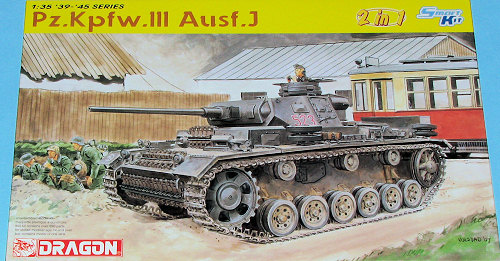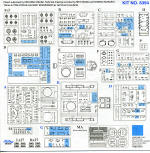
| KIT: | Dragon 1/35 Pz.Kpfw III ausf J |
| KIT #: | 6394 |
| PRICE: | $ |
| DECALS: | Eight options |
| REVIEWER: | Scott Van Aken |
| NOTES: | Smart Kit series with Magic Track links |

| HISTORY |
On January 11, 1934, following specifications laid down by Heinz Guderian, the Army Weapons Department drew up plans for a medium tank with a maximum weight of 24,000 kg and a top speed of 35 km/h. It was intended as the main tank of the German Panzer divisions, capable of engaging and destroying opposing tank forces.
Daimler-Benz, Krupp, MAN, and Rheinmetall all produced prototypes. Testing of the prototypes took place in 1936 and 1937, leading to the Daimler-Benz design being chosen for production. The first Panzer III A came off the assembly line in May of 1937, and a total of ten, two of which were unarmed, were produced in 1937. Mass production of the tank, then in model III F, began in 1939.
Between 1937 and 1940, attempts were made to standardize parts between Krupp's Panzer IV and Daimler-Benz's Panzer III.
Much of the early development work on the Panzer III was a quest for a suitable suspension. Several varieties of leaf-spring suspensions were tried on Ausf A through D before the torsion-bar suspension of the Ausf E was standardized. The Panzer III, along with the Soviet KV heavy tank, was one of the first tanks to use this suspension design.
The Panzer III was intended as the main battle tank of the German forces. It outclassed most of the tanks of the time However, when it initially met the Soviet KV and T-34 tank designs it proved to be inferior. To meet the growing need to counter the T-34 the Panzer III was upgunned with the 50mm KwK 39 L/60 and received more armor which made it a very formidable opponent for the T-34. This still failed to address the problem caused by the KV tanks though, so in 1942, several self propelled guns as well as the longer barreled 75mm Kwk 40 L/43 Panzer IV Ausf F2 and the Panzer IV Ausf G were developed and produced.
In 1942, the Ausf N model of the Panzer III was created with an L/24 75 mm gun, a low-velocity gun designed for anti-infantry and close-support work. For defensive purposes however, it did carry a few rounds of hollow charge ammunition which could penetrate 70-100mm of armor depending on the round's variant but these were strictly used for self-defensive purposes.
When compared to the earlier variants, the Panzer III Ausf J, the subject of this kit, had a longer/more effective 5 cm KwK 39 L/60 gun. This is the variant that was developed in response to the T-34 that was met in Russia. In North Africa, the earlier versions were more than a match for British tanks, but once the US Sherman was introduced at El Alamein, some were sent to the Afrika Korps as well. 1067 produced in late 1941 to mid 1942.
| THE KIT |
 Dragon prides itself in producing what they think are the most accurate armor kits around. The sheer number of kits and the high quality of their molding have made them probably the most popular armor kit company around. Even more so than Tamiya for many as much due to the quality and detail provided as to their competitive pricing.
Dragon prides itself in producing what they think are the most accurate armor kits around. The sheer number of kits and the high quality of their molding have made them probably the most popular armor kit company around. Even more so than Tamiya for many as much due to the quality and detail provided as to their competitive pricing.
This kit is no exception to that. Thanks to heavy investment into 'slide molding' technology, the ability to produce complex shapes with little or no mold seams has really put them in the front of the molding industry. The results of this technology that are immediately visible to most are things like hollowed out ends of gun barrels and exhaust.
This kit differs from their other PzKw IIIs in that it has newly molded fenders, engine deck, turret, stowage bins, torsion bars, sprockets and idler wheels and a number of other bits. There is full gun detail and the various hatches can be displayed open. It is still a 'curbside' in that there is no engine or interior detail, but the new full hull provides the space for those who want to add that to it. 
For those who like link on link tracks, Dragon has a set of their Magic Tracks for you. There is also a small photo etch fret for screens and some other small detail. Of course, with the huge number of parts, no way can I show the full layout as I usually do, so I've scanned the parts location diagram for you instead.
Instructions are superb and though appear quite crowded, provide all the information you need for assembly. That includes any optional positions of various parts. Colors are in the Gunze range and the small sheet provides markings for eight tanks in either Panzer Grey, Panzer Yellow or in winter White. All are from the 1942/43 time period and from units operating in North Africa or Russia. The decal sheet provides the marking for these vehicle and is quite well printed. Most German armor was quite light on big markings, with vehicle numbers probably being about as large as things got.
| CONCLUSIONS |
If armor is your passion, then this is a kit that you simply cannot pass by. The detail is superlative and will result in a model you are sure to treasure.
| REFERENCES |
August 2007
Thanks to www.dragonmodelsusa.com for providing the review kit. You can find this kit either on the website or at your local hobby shop. If you don't see it, ask for it.
If you would like your product reviewed fairly and quickly by asite that has nearly 400,000 visitors a month, please contactme or see other details in the